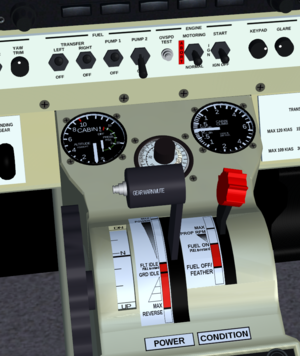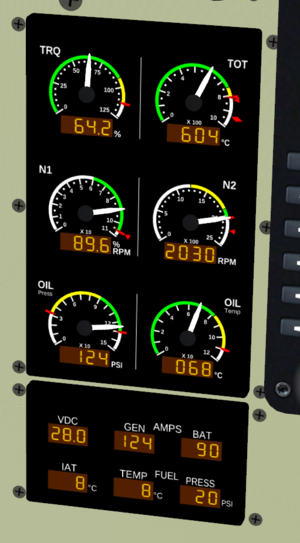Extra EA-500/engine operation
Extra 500 Engine Operation
The second most important system in any motor powered aircraft is the propulsion system.
In case of the Extra 500 there is one engine and supporting systems (fuel, ignition). The engine used is a RR250-B17F/2 with a take-off power rating of 450SHP. Like most single engined aircraft, the engine is mounted in the front. This particular engine is a twin shaft turboprop engine, meaning there is a turbine driving a propeller. The engine is a derivative from a RR250C20 helicopter engine. This brings a number of advantages: It is light (less then 100kg) and compact. A disadvantage is loses power with altitude as one runs into the TOT limit pretty fast.
| Rolls-Royce Model 250-B17F/2 | |
|---|---|
| Type | Turboprop |
| Maximum Power | 450 SHP |
| Maximum Continuous Power | 380 SHP |
| Number of Shafts | 2 |
| Weight | 96 kg |
| Length | 44.92 inch |
| Width | 18.78 inch |
| Height | 22.60 inch |
| MT-Propeller MTV-5-1-D-C-F-R(A)/CFR210-56 | |
| Type | Constant speed |
| Number of Blades | 5 |
| Diameter | 2100 mm |
| Sense of rotation | Right-hand tractor (viewed in direction of flight) |
Also look here
Supporting Systems
The engine has no FADEC, meaning it is controlled not by software, but in this case, by a sophisticated pneumatic control system. This means there are very little and relatively simple supporting systems:
- Oil System. Essential for cooling and lubrication.
- Fuel System. As long as there is fuel available at the correct flow and pressure, the engine will run.
- Ignition System. One of the few electrical powered parts. Normally only needed to start the engine, but also in flight phases with a higher risk of engine flame-out; take-off, landing, heavy rain, icing.
- Control System. Basically two main pilot inputs, the condition lever and the power lever (see below)
- Starter/Generator. A really big and heavy electrical motor both used for starting the engine as the main electrical power supplier
- Standby alternator. Electrical power generation when the above generator fails.
Pilot interfaces
The following interfaces exist:
- Power lever. Used to set the engine power, also used to set propeller in reverse.
- Condition lever. Primary function is to open/cut the fuel to the engine and thus for engine starting and shutting down. Also allows to set the propeller RPM (1900-2030 RPM)
- Start/Ignition switch. Used to start the engine and switching on ignition.
- Abort/Motoring switch. Allows to motor the engine, but also to stop the starter from trying to start the engine.
- Overspeed test button. For testing the back-up control system of the engine.
In addition you will need:
- Fuel Pump 1 and 2 switches. Make sure fuel is being delivered to the engine.
Engine indication
The main engine indicator is located on the left side of the panel. It indicates 6 parameters:
- Torque (TRQ in %). Indicates engine power.
- Turbine Outlet Temperature (TOT in degC).
- Gas producer speed (N1, %).
- Propeller speed (N2, RPM)
- Oil pressure (OP, psig)
- Oil temperature (OT, degC)
Below this indicator an other instrument shows parameters in digital format only:
- Bus Voltage (VDC)
- Generator/standby alternator current (A)
- Battery current (A)
- Indicated outside air temperature (IAT, degC)
- Fuel temperature (FT, degC)
- Fuel pressure (FP, psig)
Beside the RH IFD more fuel system parameter are displayed:
- Fuel quantity collector compartment, left and right in liter
- Fuel quantity main compartment, left and right in liter
- Fuel quantity auxiliary compartment, left and right in liter
- Fuel flow in liter per hour.
A short note on above parameters:
- With 111% TRQ and a propeller RPM of 2030, the Shaft Horse Power is 458. At the maximum continuous limit (92% TRQ) it is 380 SHP.
- N2 is displayed in propeller speed, but the power turbine (which drives the propeller) turns a lot faster. At 2030 RPM of the propeller, the power turbine turns 33290 RPM, that is 554.8 revolutions per second (not a typo)
- 100% N1 (gas producer speed) corresponds to 50970 RPM; 849.5 revolutions per second (also not a typo)
Limitations
As all aircraft engines, this aircraft has limits. There are two parameters whose limits must be actively monitored and kept by the pilot:
- TRQ: 92% continuous and 111% for 5 minutes (at take-off)
- TOT: 752 degC continuous and 810 for 5 min (at take-off). In addition at engine start the TOT may be between 810 and 927degC for 10 seconds max.
In normal operation these limit are kept with the Power Lever. Typically at lower altitudes, the TRQ limit is limiting. At higher altitudes, the TOT is limiting. When the engine is started the TOT rises very fast and a hot-start is easily provoked. Make sure you follow the starting procedures (see below).
All other limits are basically kept automatically due to limiting systems. For instance the propeller governor will keep the propeller RPM at 2030. Also the oil temperature varies with power setting, air temperature, airspeed etc. But the oil cooler and the internal thermostat will make sure that the temperature stays below the 82degC limit. An exception is if the propeller is in reverse! Make sure you keep an eye on the oil temperature as the propeller does not 'force-cool' the cooler in this case.
Engine start
There are three things that are essential for a good engine start:
- A charged battery. If you are not sure, attach External power (CTRL+E) and switch it on.
- The TOT is below 100degC prior to starting. Motor the engine to cool it down if needed. Usually only needed when you just shut the engine off or an aborted start.
- Add fuel at the correct moment: N1 between 12-15%. To early and you will have a hot start. To late and the engine will not light off (airflow through the engine is too strong already and fuel will not ignite).
Zoom so you can see the engine instruments, the start switch and the condition lever. There won't be time to move your head around. Toggle the Start switch to START (mouse wheel up) the switch will fall back in IGNITION, so no need to worry about that. At 12-15% N1: Press s ( or click on condition lever, its the red one ) to add fuel. Monitor TOT and abort the start if necessary. Monitor you get a positive oil pressure. No oil pressure will kill any turbine engine in 15 seconds.
In case of a hot start: cut off the fuel using the condition lever and switch off the electric starter by moving the motoring switch in ABORT.
After engine has started:
- Standby alternator: Switch ON
- Generator: Switch ON
- Engine start: IGN OFF (only if N1 >= 65%)
Typically one fuel pump is on, although the engine will start without it. Only at high altitude the engine won't start or even flame-out when none of the pumps are on.
Normal operation
Once the engine is started you can use the power lever to increase or decrease power. As mentioned before, make sure you stay within the TRQ and TOT limit. As the air is thinner in higher altitude, less air will go through the engine and thus the TOT will rise. Therefore, the TOT will go up while climbing without you ever touching the power lever. For fine tuning of the power, you can hover your mouse above the power lever handle and turn the mouse wheel. Use the n/N to increase/decrease propeller RPM. Note that when standing still and in low power, the propeller is at its fine pitch stop and RPM still below the propeller governor setting.
Shutting down
This is fairly easy, just shut off the fuel by moving the condition lever to cut-off, thus s or click on the condition lever.
Reverse
Reverse may only be used on the ground, so practically at the landing roll to reduce its length. In normal operation, the Power Lever travel ranges from Flight Idle to Maximum Power. Only when in Flight Idle you can pull the Power lever up (Press r) and increase power. You will see the power lever moves further back in the so-called beta range. This means that not the propeller governor is in control of the propeller blade angle, but it is linked directly to the power lever. Moving the lever back a bit will set it into Ground Idle, moving it further will turn the propeller blades in such a way a reverse thrust is produced.
To move back to the normal operating range decrease power (lever moves forward) to the stop and Press r.
Watch your oil temperature when in reverse. Normally the propeller airflow will force-cool the oil cooler, but in reverse this does not happen as the airflow induced by the propeller is reversed.
Motoring
Motoring is basically turning the engine with the starter only. So no ignition, no fuel. It is used to cool down the engine or in maintenance after the fuel or oil system has been serviced. To motor move the motoring switch into MOTORING. The engine will run up to ~20% N1. Careful as motoring will drain the battery significantly, using external power is advised.
Overspeed Test
As mentioned before, the engine is controlled by a pneumatic system. There are several layers of control.
The first one controls fuel flow. Then there is a system that makes sure maximum speeds are not exceeded. And this system has a back-up system. Now this back-up system normally is not needed, meaning that it could fail without the pilot noticing. Therefore it is tested using the overspeed test button.


